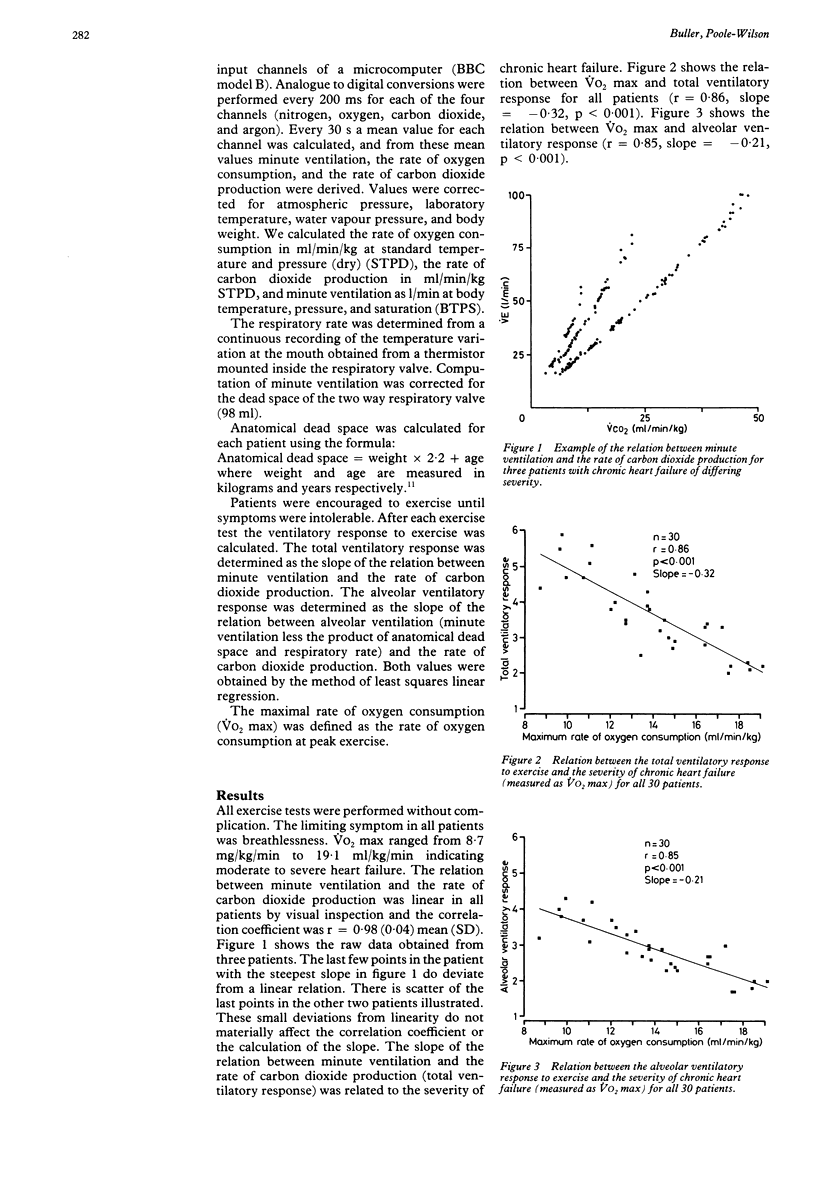Abstract
Minute ventilation, respiratory rate, and metabolic gas exchange were measured continuously during maximal symptom limited treadmill exercise in 30 patients with stable chronic heart failure. The ventilatory response to exercise was assessed by calculation of the slope of the relation between minute ventilation and rate of carbon dioxide production. There was a close correlation between the severity of heart failure, determined as the maximal rate of oxygen consumption, and the ventilatory response to exercise. Reanalysis of the data after correction for ventilation of anatomical dead space did not significantly weaken the correlation but reduced the slope of the relation by approximately one third. These results show that the increased ventilatory response to exercise in patients with chronic heart failure is largely caused by mechanisms other than increased ventilation of anatomical dead space. This finding supports the concept that a significant pulmonary ventilation/perfusion mismatch develops in patients with chronic heart failure and suggests that the magnitude of this abnormality is directly related to the severity of chronic heart failure.
Full text
PDF


Selected References
These references are in PubMed. This may not be the complete list of references from this article.
- Davies N. J., Denison D. M. The measurement of metabolic gas exchange and minute volume by mass spectrometry alone. Respir Physiol. 1979 Feb;36(2):261–267. doi: 10.1016/0034-5687(79)90029-x. [DOI] [PubMed] [Google Scholar]
- Fink L. I., Wilson J. R., Ferraro N. Exercise ventilation and pulmonary artery wedge pressure in chronic stable congestive heart failure. Am J Cardiol. 1986 Feb 1;57(4):249–253. doi: 10.1016/0002-9149(86)90900-8. [DOI] [PubMed] [Google Scholar]
- Franciosa J. A., Leddy C. L., Wilen M., Schwartz D. E. Relation between hemodynamic and ventilatory responses in determining exercise capacity in severe congestive heart failure. Am J Cardiol. 1984 Jan 1;53(1):127–134. doi: 10.1016/0002-9149(84)90696-9. [DOI] [PubMed] [Google Scholar]
- Gazetopoulos N., Davies H., Oliver C., Deuchar D. Ventilation and haemodynamics in heart disease. Br Heart J. 1966 Jan;28(1):1–15. doi: 10.1136/hrt.28.1.1. [DOI] [PMC free article] [PubMed] [Google Scholar]
- Harrison T. R., Pilcher C. STUDIES IN CONGESTIVE HEART FAILURE: II. The Respiratory Exchange During and After Exercise. J Clin Invest. 1930 Apr;8(3):291–315. doi: 10.1172/JCI100265. [DOI] [PMC free article] [PubMed] [Google Scholar]
- Lipkin D. P., Perrins J., Poole-Wilson P. A. Respiratory gas exchange in the assessment of patients with impaired ventricular function. Br Heart J. 1985 Sep;54(3):321–328. doi: 10.1136/hrt.54.3.321. [DOI] [PMC free article] [PubMed] [Google Scholar]
- Rubin S. A., Brown H. V., Swan H. J. Arterial oxygenation and arterial oxygen transport in chronic myocardial failure at rest, during exercise and after hydralazine treatment. Circulation. 1982 Jul;66(1):143–148. doi: 10.1161/01.cir.66.1.143. [DOI] [PubMed] [Google Scholar]
- Wilson J. R., Ferraro N. Exercise intolerance in patients with chronic left heart failure: relation to oxygen transport and ventilatory abnormalities. Am J Cardiol. 1983 May 1;51(8):1358–1363. doi: 10.1016/0002-9149(83)90312-0. [DOI] [PubMed] [Google Scholar]
- Wilson J. R., Fink L. I., Ferraro N., Dunkman W. B., Jones R. A. Use of maximal bicycle exercise testing with respiratory gas analysis to assess exercise performance in patients with congestive heart failure secondary to coronary artery disease or to idiopathic dilated cardiomyopathy. Am J Cardiol. 1986 Sep 15;58(7):601–606. doi: 10.1016/0002-9149(86)90283-3. [DOI] [PubMed] [Google Scholar]


